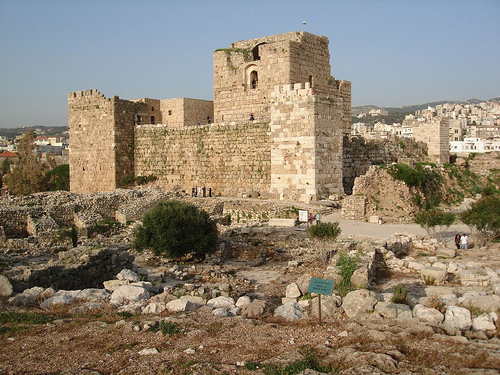

Location: Byblos, Mount Lebanon Governorate Map
Constructed: 12th century by Crusaders
Byblos Castle is a massive medieval stronghold situated in Byblos of Mount Lebanon Governorate in Lebanon. It was constructed in early 12th century by Crusaders who wanted to strengthen their presence in the conquered lands in the Holy Land. The name "Byblos" or "papyrus" given to the ancient city those ruins you can see in the vicinity of the castle was given due to importance of this commodity traded since the ancient times. European knights constructed their citadel from local limestone as well as salvaged stone from much older structures from an ancient town of Byblos near by. Don't be surprised if you see ancient Roman columns and inscriptions within walls of the castle.
Byblos Castle was defended by four smaller tower at the corners of the square citadel and a fifth large tower defended the entrance to the Byblos fortress. A moat was dug around a perimeter to defend against siege machines. Despite intricate military fortifications, it didn't stop great Muslim commander Saladin from capturing the citadel in 1188. He subsequently destroyed part of the defensive walls so that Christian armies couldn't use them. Just seven years, in 1197 the castle was recaptured by the Crusaders who quickly repaired damages. After Holy Land was completely lost by the armies from Europe, Byblos Castle was used by the Mamluks for several centuries as a base of their military presence in the region. Underground structures of the citadel is the best part of the complex. Unlike other part of Byblos Castle they saw little alterations and was perfectly preserved in its original condition.
The building material for the castle was taken from the ancient temple complex in Byblos, and the columns of ancient temples were used to reinforce the wall. The castle was built from stone blocks that were very roughly hewn for this area. The castle originally consisted of a rectangular keep measuring 17.6 by 21.3 meters. The keep had two floors, with the first floor, which also served as a living room, only accessible via a ladder. The floors were vaulted, which gave the keep additional stability. There was also the massive masonry. A circular wall, also rectangular, surrounded the tower. Rectangular defensive towers were also built at every corner or those already built were improved.
In the aftermath of the First Crusade, the town of Gibelet was
conquered on April 28, 1103 by Raymond of Toulouse with the help of a
Genoese fleet under William I Embriaco. The Crusaders then built the
castle. The castle and the surrounding land were initially transferred
proportionately and then completely in 1109 to the Genoese, who
appointed William's son Hugo I Embriaco as administrator and first lord
of Gibelet. Over time, he and his descendants expanded their office into
a hereditary fiefdom. The Genoese Embriaco family owned the fief - with
the exception of a few years when Saladin occupied the place - until
1302.
During the Crusades, this was also the seat of the Latin
diocese of Gibelet, which was founded in 1138.
In 1187 Hugo III
had to. After a siege, Embriaco handed the place and the castle over to
Saladin in exchange for free withdrawal. In 1190, when Saladin received
news of Frederick Barbarossa's approaching crusade, he gave the order to
raze the castle, which was only partially successful. In 1197 the town
and castle were destroyed by Henry VI's crusade. recaptured and handed
over to Guido I Embriaco, who had the castle repaired.
Guido's
son Henry I Embriaco rebelled against his feudal lord, the Count of
Tripoli, as part of the War of Saint-Sabas from 1256 and declared
himself independent of him with the support of Genoa. The conflict only
ended when Count Bohemund IV of Tripoli conquered Gibelet Castle in 1282
and executed Guido II Embriaco and his brothers Johann and Baldwin.
Guido's son and heir Peter I Embriaco was only able to regain de facto
control over Gibelet after the death of Bohemund IV in 1287.
When
the Mamluks conquered and destroyed the surrounding cities of Tripoli,
Botrun and Nephin in 1289, Peter I Embriaco had already agreed with the
Mamluk Sultan Qalawun to submit in return for tribute. The Mamluk
sultans left the family in their control until they apparently gave up
the property peacefully in 1302 at the latest. The historian Steven
Runciman suspects that the family was able to hold out against the
Mamluks for so long because, as lords of Gibelet, they could be sure of
the traditional support of the Maronites of the Lebanese mountains.
In 1369 the place was sacked by a fleet from Famagusta (Crusader
Kingdom of Cyprus).
1109–1135: Hugo I Embriaco († around 1135), his son, ⚭ Adelasia
1135–1159: William II Embriaco († around 1159), his son, ⚭ Sancha from
Provence
1159–1184: Hugo II Embriaco († around 1184), his son
1184–1187: Hugh III. Embriaco († 1196), his son, ⚭ 1179 Stephanie von
Milly
1187–1197: occupied by Saladin
1197–1238: Guido I Embriaco
(† 1238), son of Hugo III, ⚭ 1204 Alix, daughter of Bohemond III, Prince
of Antioch, and Sibyl
1238–1271: Henry I Embriaco († 1271), son of
Guido I, ⚭ 2) 1250 Isabella, daughter of Balian of Ibelin, Lord of
Beirut, and Eschiva of Montbéliard
1271–1282: Guido II Embriaco (†
1282), son of Henry I, ⚭ Margaret, daughter of Julian Garnier, Count of
Sidon
1282/87–1298: Peter I Embriaco († 1298), son of Guido II, ⚭ 1)
Douce de Gaurelée, widow of John of Picquigny, ⚭ 2) his niece Agnes
Embriaco, widow of Gauvain de la Roche, chamberlain from Jerusalem
1298–1302: Maria Embriaco († 1331), daughter of Guido II, ⚭ 1295 Philip
of Ibelin (* 1253; † 1318), Seneschal of Cyprus